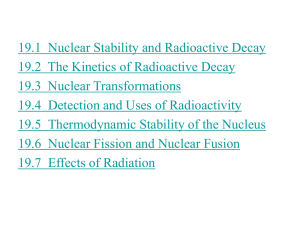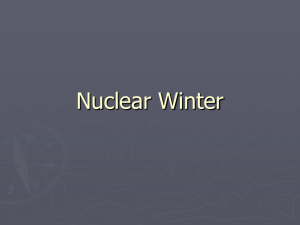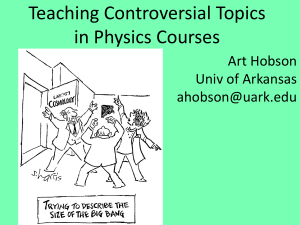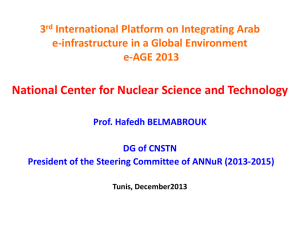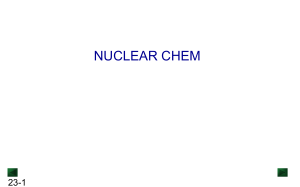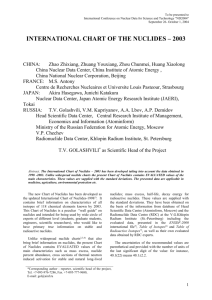Chapter 21 - Richsingiser.com
advertisement
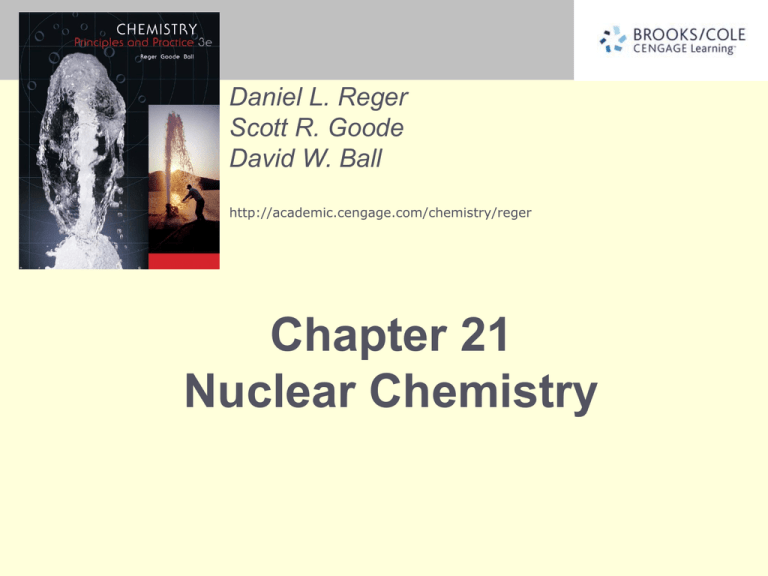
Daniel L. Reger Scott R. Goode David W. Ball http://academic.cengage.com/chemistry/reger Chapter 21 Nuclear Chemistry Review • Most naturally occurring elements are mixtures of isotopes, which are represented by symbols of the form A Z X where X is the symbol of the element, A = mass number, and Z = atomic number. • Nuclide is the nucleus of a specific isotope. • A nucleon is a proton or neutron. Definitions • A stable isotope is one that does not spontaneously decompose into another nuclide. • An radioactive nuclide is one that spontaneously decomposes into another nuclide. Stable Nuclide Characteristics 1 The number of neutrons is equal to or greater than the number of protons (except for 1H and 3He). 2 Up to Z = 20, the number of neutrons and protons are nearly equal; above 20 the ratio of n/p increases slowly to about 1.6:1. 3 Nuclear stability is greater for nuclides containing even numbers of protons, neutrons, or both. Stable Nuclide Characteristics 4 Certain numbers of protons and neutrons (called magic numbers) confer unusual stability: 2, 8, 20, 26, 28, 50, 82, and 126. 5 The zone of stability contains all of the stable nuclides, but some nuclides in this band are unstable. 6 Tc (Z=43), Pm (Z=61), and all elements beyond Bi (Z=83) have no stable isotopes. Radioactivity • There are three major kinds of emissions from radioactive. α particles are high-energy 4He nuclei. β particles are high-energy electrons that originate from the nucleus. γ rays are very short wavelength (high energy) electromagnetic radiation. Nuclear Equations • A nuclear equation describes any process in which a nuclide undergoes change. In a balanced nuclear equation the sum of the mass numbers and atomic numbers on the reactant and product sides of the equation must be equal. 238 92 U Th 234 90 4 2 Z: 92 = 90 + 2 A: 238 = 234 + 4 Alpha Decay • An alpha decay decreases the atomic number by 2 and the mass number by 4. 232 228 4 90 Th 99 Ra 2 • Alpha decay is seen in all elements heavier than bismuth (Z > 83). Beta Decay • Beta decay increases the atomic number by one, without changing the mass number. 14C 14N + 0 7 6 -1 • The β particle does not exist in the nucleus, but is created at the instant of its emission. • Beta emission is observed in nuclides that have too many neutrons to be stable. Positron Emission • A positron is identical to an electron, except its charge is positive. • Positron emission decreases the atomic number by one, without changing the mass number. 40 19 K 40 18 Ar β 0 1 • The symbol for the positron and beta particle is the same, except for the sign of Z. • Positron emission is seen in nuclides that have too many protons to be stable. Electron Capture • In electron capture an electron in a low energy orbital of the atom is capture by the nucleus and converts a proton to a neutron. 44 0 44 22Ti 1e 21Sc • X rays (not g rays) accompany electron capture, because the atom produced is in an excited electronic state. • Electron capture and positron emission both decrease the atomic number by 1. • Both processes occur when the nuclide contains too many protons to be stable. Predicting Modes of Decay For radioactive elements • When Z > 83, an emission is often observed. • If A > atomic mass 0 of element 1 decay occurs. • If A < atomic mass of element 01 decay or electron capture occurs. Example Problem • Predict the mode of decay, and write the nuclear equation for each radioactive nuclide: (a) 226 88 Ra (b) 22 11 Na (c) 130 53 I Radioactive Series • Among the heavier elements radioactive decay series are common. Detecting Radiation • Radiation detection is based on the ionization caused by high energy particles and light and includes: • Exposure of photographic film. • Geiger counters. • Scintillation counters. Decay Rates • Radioactive decays obey a first order rate law: - N rate = kN t where N is the number of radioactive nuclei. • Usually the half-life, t1/2, is given rather than k. ln 2 0.693 t1/2 k k Nuclear Transmutation • A nuclear transmutation is a reaction in which two particles or nuclides produce nuclides that are different than the reactant species. • Two of the first nuclear transmutations observed were: 14 7 9 4 N O p 4 2 17 8 1 1 Be C n 4 2 12 6 1 0 Nuclear Reactions of Charged Particles • When both reactants in a nuclear transmutation are positively charged, very high energies are needed because of electrostatic repulsion. • Devices used to produce these high energy particles include cyclotrons and linear accelerators. Energy and Mass • The energy equivalent of mass is calculated from E = mc2 where E is energy, m is mass, and c is the speed of light. • When a nuclear change occurs a measurable difference in the mass of the products and reactants is observed. Nuclear Binding Energy • Nuclear binding energy is the amount of energy required to keep the protons and neutrons together in the nucleus. • Some of the mass of the nucleons is converted into binding energy. • The mass of a nuclide is always less than the masses of the neutrons and protons present. Mass Defect • The mass defect is the difference between the mass of the nucleons and the mass of the nuclide. • The larger the mass defect, the greater is the nuclear binding energy. Calculating Mass Defect • The mass of a 7Li atom is 7.016003 u. Calculate the mass defect (in u) given the following masses: 1H 1.007825 u 1 n 1.008665 u o Nuclear Binding Energy from Mass Defect • The 7Li nuclide has a mass defect of 0.042132 u. Calculate the binding energy of this nuclide, in kJ/mol, using the equation DE = Dmc2 Nuclear Fission • Nuclear fission forms two nuclei of roughly similar size from a single heavy nucleus. • Fission reactions release very large quantities of energy (“exergonic”) and produce several neutrons in addition to two nuclides. 236 141 92 92 U 56 Ba + 36 Kr +3 1 0n Fission Yield Curve • More than 370 nuclides, with A = 72 to 161, are found from the fission of 235U. Chain Reaction of • 235U 235U absorbs a neutron which induces fission, and a chain reaction. Critical Mass • The critical mass is the minimum mass needed for a nuclear chain reaction to maintain a self-sustaining reaction. Nuclear Power Reactor • In a nuclear power reactor, conditions maintain criticality at a constant power level. Nuclear Power and Safety • Long term storage of radioactive fission products and fear of disastrous accidents are the major deterrents to increased use of nuclear power. • Current technology incorporates the radioactive waste in glass loaded into stainless steel containers, which are buried deep underground. • Strict government regulations are enforced to assure the safe operation of reactors. Reactor Designs • Nuclear fusion is the combination of two light nuclides to form a larger one. • The energy produced by the sun comes from fusion reactions, such as 1 1 2 0 7 E = -9.9 10 kJ/mol 1H 1H 1H 1n 1 2 3 8 E = -5.2 10 kJ/mol 1H 1H 2 He 3 1 4 0 9 2 He + 1H 2 He + 1 β E = -1.9 10 kJ/mol Reactor Designs • The possibility of fusion reactors is at least several decades away from reality. • An international consortium of the U.S., Japan, Russia, and the European Community are jointly designing a experimental thermonuclear power reactor. Units of Radioactivity and Radiation Dose Radioactivity Name Abbrev Definition or conversion SI unit Becquerel Bq Common unit Curie Ci 1 disintegration /second 3.7 1010 disintegrations /second rad Quantity of radiation that transfers 1 10-2 J of energy per kilogram of matter Sv rem 1 Sv = 100 rem 1 rem = 0.01 Sv Radiation Dose SI unit rad Effective Radiation Dose SI unit Common unit Sievert rem Most Radiation has a Natural Source Radon • 222Ra is produced by the decay of natural 238U found in rocks such as granite. • Home radon test kits are sold because of the great public awareness and the potential dangers of radon accumulation. • Since radon generally enters homes through the basement, one of the most effective means of eliminating the radiation danger is to add ventilation fans in the basement. Nuclear Medicine • When a patient has an overactive thyroid gland, he or she is often given a dose of 131I, which is a beta-emitter. • Iodine concentrates in the thyroid gland, and the beta radiation from the 131I isotope reduces the amount of hormone produced by the thyroid gland. CT Scans • Radiopharmaceuticals are synthesized with isotopes that emit gamma radiation coupled to organic molecules that are taken up specifically in target organs. • Modern scanners use gamma ray cameras that take measurements at thousands of different locations. • Computerized tomography is often abbreviated CT and referred to as a CT scan. Gamma Radiation Scans - 99mTc • Technicium is a transition metal with a variety of stable oxidation states that makes it an excellent species to use to react with organic molecules. • Heart imaging is done with a compound formed by technicium(I) and six isonitrile ligands. • Other compounds have been developed for mapping the brain, lungs, etc. • Over 100 different nuclear medicine diagnoses are available to clinicians. Positron Emission Tomography (PET) Scans • A fluorinated sugar (fluorodeoxyglucose) that contains 18F is often used. • This sugar is taken up most by the organs that are subdividing most quickly. And cancer cells are among the fastest. • PET scans are particularly effective in diagnosing lung, head and neck, colorectal, esophageal, lymphoma, melanoma, breast, thyroid, cervical, pancreatic, and brain cancers.
